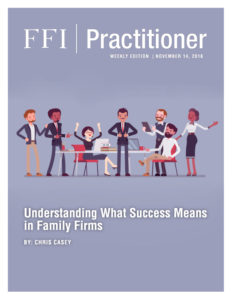
View this edition in our enhanced digital edition format with supporting visual insight and information.
Thanks to Chris Casey for sharing his thoughts on what success means in family firms and some of the difficulties he encountered as he worked on his dissertation “Defining success in family firms using configurational fit: A quantitative study of family-owned construction firms” from Capella University.
As a practitioner working with family firms, how often have you asked, “How do you define and measure success in your family business?”
During my time as a second-generation leader of a steel manufacturing company, this question became of increasing interest to me, from both a scholarly and practical perspective. Like many family firm leaders, we had our hands in everything: bookkeeping; operations; sales; etc. I came to realize that our internal, unspoken definition of success went well beyond gross revenues or net income. Rather, our definition of success included many non-financial outcomes, accruing as much to the family as to the business.
As I matured in our family firm, I was (fortunately) able to interact with peers in other family businesses. And, I noticed over time that they often had different ways of describing what success meant for them. So, when I decided to embark on a formal program of studying family firms, the question that most often guided my doctoral research in 2013 was this: How do you define and measure success in family firms?
Recently I posed that question to a group of generational family firms with whom I have worked closely over the last seven years as part of forming and now running a purchasing cooperative. If you have ever asked this question of your family firm clients, it will not be surprising that the answers can be quite divergent. Only about 25% of responses included variations on a financial theme as part of their definition of success, e.g., profit, financial success or stability, making payroll. The themes of the other 75% of responses focused on intangible and qualitative factors, such as:
- Honesty and integrity
- Sustainability and longevity
- Having fun and sharing with family
- Creating a legacy or future for our kids
So, what is success?
On this topic, the field of scholarly research has yet to resolve the lingering questions even today. What is clear, however, is that success is a multi-dimensional construct. Success includes direct and indirect, as well as quantitative and qualitative, facets. Some authors on the subject refer to success as broader set of goals and aspirations (outcomes) sought by family firms as compared to nonfamily firms. An article, “Financial Performances of Family Firms” by Amit and Villalonga (The SAGE Handbook of Family Business, 2014) suggests that the conflicting research findings may be a result of the core confusion about how success is defined and measured by family firms.
So, what does this mean for the family firm practitioner?
For practitioners advising family firm leaders, understanding how your client defines success becomes critical when seeking, first to diagnose, and second to suggest, actions meant to improve overall firm performance. Said another way, if you cannot define the problem, you cannot offer an effective solution.
As I mentioned earlier, my ultimate research focus was on how to define and measure success, and to do so in a quantitative manner. However, that was not the original path for my research. When I started the research, my intent was to explore how the concepts of emotional intelligence could be applied to explain differences in performance among family firm leaders. Given the inherently emotional nature of many family firms, this seemed an obvious (and easy) dissertation to pursue. However, the research very quickly hit a wall when it became apparent that there was no consistent and quantitative benchmark for success among family firms. For practitioners, this is a common challenge.
From personal experience running a family firm, studying family firms, and now interacting with family firms on a daily basis, my approach to resolving the ambiguity of what success means focuses on how success – even as a multi-dimensional, inherently qualitative construct – could be quantified. One approach to quantify success in family firms is configurational fit, more commonly known as gap analysis.
Gap analysis as an analytical technique can be particularly useful for family firm advisers. Using gap analysis, you can identify both strengths and weaknesses in the firm and highlight the gap between what is good and what is not. Strategies can then be offered to “close the gap,” thus allowing the family firm to turn weaknesses into strengths over time. Gap analysis considers not only the different kinds of family firms, but also their own unique views on the myriad of components that make up success. In future issues of FFI Practitioner, I look forward to sharing my research in gap analysis and delving deeper into how practitioners can better understand and apply the principles of gap analysis to target strategic improvements in family firm success.
About the contributor
 Chris Casey, CS, PhD, is the co-founder and executive director of the Independent Steel Alliance (ISA). Prior to forming ISA, Casey was the president and second-generation owner of Bec-Don Ringgold, Inc., an independent supplier of fabricated reinforcing steel to the construction industry. He can be reached at [email protected].
Chris Casey, CS, PhD, is the co-founder and executive director of the Independent Steel Alliance (ISA). Prior to forming ISA, Casey was the president and second-generation owner of Bec-Don Ringgold, Inc., an independent supplier of fabricated reinforcing steel to the construction industry. He can be reached at [email protected].
About the Independent Steel Alliance (ISA)
ISA is a first-of-its-kind purchasing alliance formed among independently owned and operated rebar fabricators in the U.S. and Canada. ISA was launched in 2012 and has steadily grown its membership and supplier base, with the members collectively representing more than 10% of the total rebar market consumption in the U.S. and Canada.

View this edition in our enhanced digital edition format with supporting visual insight and information.





